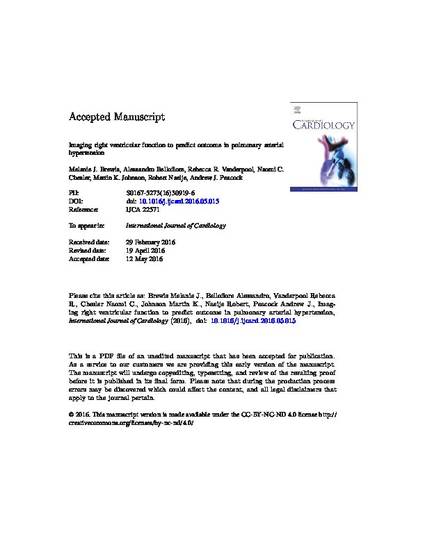
Article
Imaging right ventricular function to predict outcome in pulmonary arterial hypertension
International Journal of Cardiology
(2016)
Abstract
Right ventricular (RV) function is a major determinant of outcome in pulmonary arterial hypertension (PAH). However, uncertainty persists about the optimal method of evaluation.
Methods
We measured RV end-systolic and end-diastolic volumes (ESV and EDV) using cardiac magnetic resonance imaging and RV pressures during right heart catheterization in 140 incident PAH patients and 22 controls. A maximum RV pressure (Pmax) was calculated from the nonlinear extrapolations of early and late systolic portions of the RV pressure curve. The gold standard measure of RV function adaptation to afterload, or RV–arterial coupling (Ees/Ea) was estimated by the stroke volume (SV)/ESV ratio (volume method) or as Pmax/mean pulmonary artery pressure (mPAP) minus 1 (pressure method) (n = 84). RV function was also assessed by ejection fraction (EF), right atrial pressure (RAP) and SV.
Results
Higher Ea and RAP, and lower compliance, SV and EF predicted outcome at univariate analysis. Ees/Ea estimated by the pressure method did not predict outcome but Ees/Ea estimated by the volume method (SV/ESV) did. At multivariate analysis, only SV/ESV and EF were independent predictors of outcome. Survival was poorer in patients with a fall in EF or SV/ESV during follow-up (n = 44, p = 0.008).
Conclusion
RV function to predict outcome in PAH is best evaluated by imaging derived SV/ESV or EF. In this study, there was no added value of invasive measurements or simplified pressure-derived estimates of RV–arterial coupling.
Keywords
- Pulmonary hypertension,
- Pressure–volume relationship,
- Prognosis,
- Right ventricular dysfunction
Disciplines
Publication Date
September 1, 2016
DOI
10.1016/j.ijcard.2016.05.015
Publisher Statement
This is the Accepted Manuscript of an article that was published in the International Journal of Cardiology, volume 218, 2016. © 2016. This manuscript version is made available under the CC-BY-NC-ND 4.0 license http://creativecommons.org/licenses/by-nc-nd/4.0/
The Version of Record is available online at this link.
SJSU Users: use the following link to login and access the article via SJSU databases.
Citation Information
Alessandro Bellofiore, Melanie J. Brewis, Rebecca R. Vanderpool, Naomi C. Chesler, et al.. "Imaging right ventricular function to predict outcome in pulmonary arterial hypertension" International Journal of Cardiology Vol. 218 (2016) p. 206 - 211 ISSN: 0167-5273 Available at: http://works.bepress.com/alessandro_bellofiore/17/
Creative Commons license

This work is licensed under a Creative Commons CC_BY-NC-ND International License.
